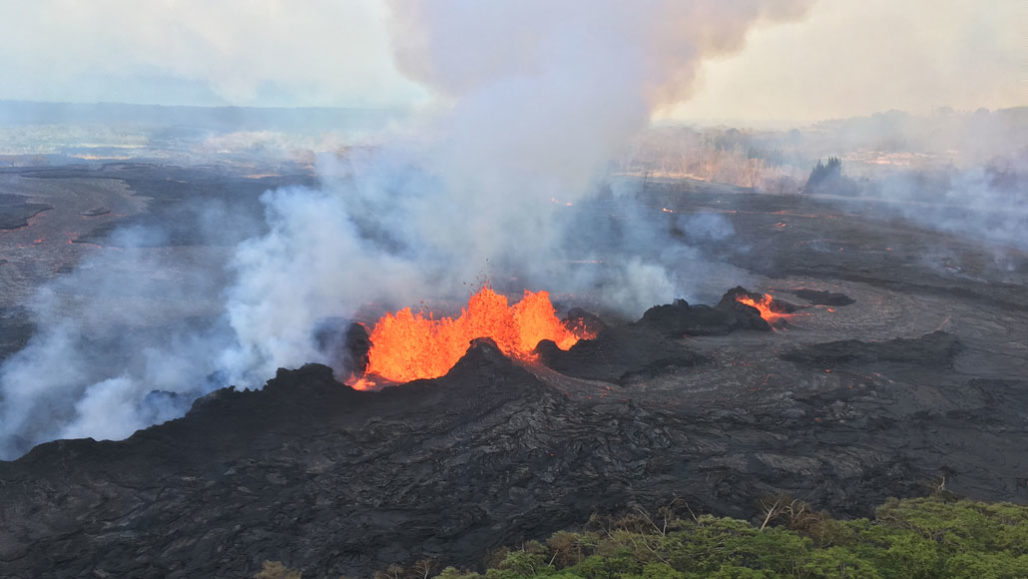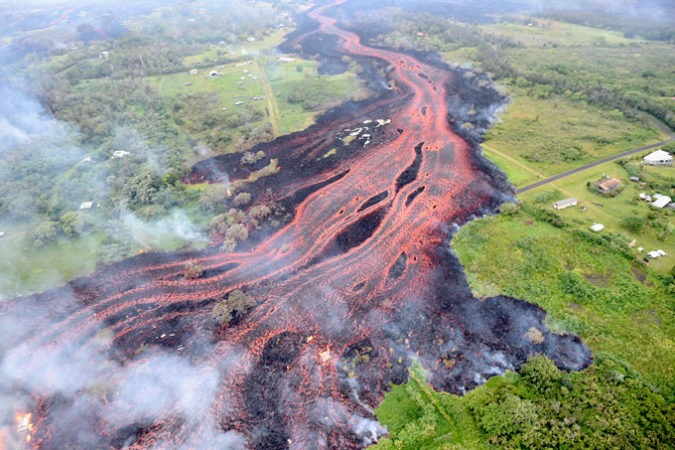Did rain put the Kilauea volcano’s lava-making into overdrive?
In mid 2018, the volcano spewed as much lava as it normally would in 10 to 20 years

Two scientists propose that weeks of heavy rain may have triggered volcanic activity at Kilauea in 2018, marked by new cracks in Earth’s crust that sent lava into the air (as here on May 22).
USGS
By Megan Sever
Heavy rains can trigger Hawaii’s Kilauea volcano to spout streams of lava. That’s the assessment of a new study. The idea is possible, many volcano experts say. However, some don’t believe that the data here support the that conclusion.
Starting in May 2018, Kilauea dramatically ramped up its 35-year-long eruption. It opened 24 new cracks in Earth’s crust. Some of these shot fountains of lava 80 meters (260 feet) into the air. And there was a lot of lava. The volcano spewed as much of it in just three months as it normally does in 10 or 20 years!
What sent this lava production into overdrive? The new analysis suggests it was rain. In the months before, there had been lots and lots and lots of rain.
The idea is that large amounts of this rain seeped into the ground. This could have boosted pressure within the rocks. That pressure could have created zones of weakness. Eventually the rock would have fractured. And fractures offer “new pathways for molten magma to make its way to the surface,” points out Jamie Farquharson. He’s a volcanologist who works at the University of Miami in Florida.
Kilauea received more than double its average rains during the first three months of 2018. The volcano’s rocks are highly permeable. That means rains can percolate kilometers (miles) down through them. That water could end up close to a volcanic chamber holding magma.
Farquharson worked with Falk Amelung. He’s a geophysicist at the University of Miami. They used computer models to calculate how the frequent heavy rains might have put pressure on the volcano’s rock. That pressure would have been less than the amount caused by daily tides, they found. Still, these rocks had already been weakened by years of volcanic activity and earthquakes. Extra pressure from the rains might have been enough to break the rocks, the model suggested. And that could have unleashed a steady flow of lava.
But the “most compelling” evidence for the rain-trigger theory? Archived records that go back to 1790. They show that “eruptions seem to be approximately twice as likely to begin during the wettest parts of the year,” says Farquharson.
He and Amelung saw little evidence of much uplifting of the ground — either at the volcano’s summit or in its underground plumbing system. A lot of uplift would be expected, they say, if the eruptions were due to new magma pumping to the surface.
Farquharson and Amelung made their case for rain-triggered lava at Kilauea April 22 in Nature.

Some praise, some push back
“This research is super exciting” says Thomas Webb, “especially because it is very interdisciplinary. Webb is a volcanic meteorologist in England at the University of Oxford. He particularly likes this approach that linked cycles of pressure inside the volcano with weather conditions.
One interesting question, he says, is whether rainfall increases due to climate change might affect how volcanoes behave in the future. “I would really like to see future work from these authors” address that issue, he says.
Michael Poland was less impressed with the new study. “We’re skeptical of the findings,” he says. Poland is a volcanologist in Vancouver, Wash., who has worked at Kilauea. He’s part of a research team at the U.S. Geological Survey. The Miami group’s conclusion, he says, contradicts observations by his agency’s Hawaiian Volcano Observatory. Those data showed major ground deformation at Kilauea. He says that points to building pressure deep under the volcano’s summit before lava erupted out of cracks in the ground.
Poland says his team is now preparing a response to the new paper. It will argue, he says, “for a different mechanism” to explain Kilauea’s overproduction of lava in 2018. His group plans to highlight “data that the [Miami] authors might have missed.”
For example, most activity between 1983 and 2018 occurred at Kilauea’s cone. It’s known as Puu Oo. There, scientists had observed changes in ground motion beginning in mid-March. They were caused by changes in underground pressure. “We attribute this to a backup in [Kilauea’s] plumbing system,” Poland says.
Pressure eventually built up at Puu Oo. Then it backed up throughout the system. It went all the way to the volcano’s summit. That was 19 kilometers (11 miles) away. In time, pressure increased throughout the whole system. Earthquake activity also rose, Poland notes. This likely was due to increased pressure on the rocks. He notes another direct measure of pressure: a rise in the level of the lava lake within the summit’s caldera.
For the Miami team’s assessment to be right, Poland says, the whole Kilauea system should have shown no pressure buildup before the eruption.
Poland also sees problems with other arguments by the Miami scientists. For instance, the plumbing system beneath Kilauea is complex. Most computer models are too simple to figure out how water moves through such a complex route. And without that, it would have been hard for the model to gauge how and where water might have boosted pressure on rocks far below.
Poland does, however, find “interesting” the idea that rain could cause weaknesses in the ground that lead to lava eruptions. In fact, he notes, it’s the same process by which fracking (or injecting wastewater underground) has triggered earthquakes in some regions.







